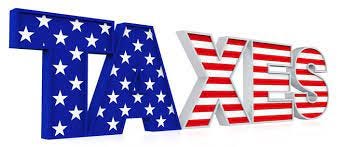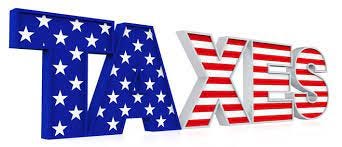The History of Taxation in the United States
It started way before that tea was thrown into the ocean…
Issue #112 American History August 16, 2022
It’s Complicated
Taxes have been levied against the population and have been contested in one way or another since time immemorial. In the over two centuries of United States history, taxes have been collected by all of the different jurisdictions for a multitude of reasons, starting back when we were colonies of the British government.
Please remember to view the important information at the end of this article. Thanks!
The British Colonies are taxed
1765 The first direct tax levied on the colonies was for every single piece of paper: ships’ papers, court documents, advertisements, and playing cards.
1767 The “Townshend Revenue Act” levied duty taxes on the colonies for imports of British china, glass, lead, paper, and tea. The colonists objected with “No taxation without representation!”
1770 The colonists and the British army clashed over a boycott of British goods. The March 5 “Boston Massacre,” in which the first colonist killed was a Black man named Crispus Attucks who had escaped slavery and became a sailor, led to the repeal of all of the Townshend duties except for tea.
1773 The Boston Tea Party happened on December 16. Britain previously gave the British East India Company a monopoly on tea sold in the colonies on May 10. A large group of colonists boarded the three ships in Boston Harbor that were carrying tea and threw all 342 chests of tea into the water.
1797 The first estate tax was enacted to help fund the United States Navy. The estate tax has been repealed and reinstated several times over the centuries, and the modern estate tax was implemented in 1916.
The 18th and 19th Centuries
1787 The new United States Constitution gave Congress the power to collect import and excise taxes and duties, including an “importation tax” on slaves.
1791 and 1794 In 1791, Secretary of the Treasury Alexander Hamilton implements an excise tax on whiskey. That tax was intended to help bring down the country’s huge debt load. Farmers in western Pennsylvania, who distilled and sold whiskey, opposed and eventually revolted against the tax on whiskey. In 1974, President George Washington send Federal troops to Pennsylvania to quell what came to be known as the “Whiskey Rebellion.”
1862 President Abraham Lincoln instituted the first income tax to help to pay the expenses of the Civil War. For people whose annual income ranged from $600 to $10,000 ($15,000 - $250,000 in 2019 dollars), the income tax rate was 3%. For people whose annual income was above $10,000 ($250,000 in 2019 dollars), the income tax rate was 5%. In subsequent years, the income tax was repealed and reinstated twice.
The 1st Half of the 20th Century As more and more Americans left the farms and moved to the cities to work in the industrial sector, and the United States was involved in two world wars, the tax structures were changed to reflect these situations.
1913 The 16th Amendment was established and a federal income tax was ratified. Individuals and corporations were taxed and the first Form 1040 was created. The rate for workers earning over $3,000 ($77,000 in 2019 dollars) was 1%, while the rate on income over $500,000 ($12.8 million in 2019 dollars) was 7%. However, less than 1% of the population earned enough to pay the income tax.
1918 The top tax rate was raised to 77% to help defray expenses from World War I.
1935 During the Great Depression, the Social Security Act was passed to give Americans an old-age pension program, unemployment insurance, and funding for health and welfare programs. Employees and their employers shared a 2% tax on the first $3,000 ($55,000 in 2019 dollars) of earned income.
1942 and 1943 The Revenue Act, which was described by President Franklin D. Roosevelt as “the greatest tax bill in American history,” increased the types of taxes levied and the number of Americans subject to income tax as the United States was coming out of the Great Depression and was also involved in World War II. Individual and corporate tax revenue increased from $3.4B in 1941 to$ 8B ($123.8B in 2019 dollars) in 1942. In 1943, the Current Tax Payment Act was passed, which required employers to withhold taxes from their employees’ wages and remit the funds to the Federal government quarterly.
The 2nd Half of the 20th Century and the 1st Quarter of the 21st Century
1961 The Internal Revenue Service (IRS) starts transitioning to computer data processing assisted by the National Computer Center located in Martinsburg, West Virginia.
1986 During the administration of President Ronald Reagan, the Tax Reform Act, which purported to make the tax code simpler and fairer, was passed. Included in its 300 provisions are cuts to individual top tax rates from 50% to 28%, increasing of capital gains taxes from 20% to 28%, and reducing the number of corporate tax breaks.
1992 Electronic filing of federal income taxes is available for the first time.
2001 During the administration of President George W. Bush, the Economic Growth and Tax Relief Reconciliation Act was passed, helping Bush to implement large tax cuts. The lowest individual tax rate was now 10%, and the top individual tax rate was reduced from 39.6% to 35%.
2017 During the administration of Donald Trump, Congress passed the Tax Cuts and Jobs Act, which reduced tax rates and made some deductions more restrictive. The corporate tax rate was reduced from 35% to 21% and eliminated personal exemptions. The promise of this tax reduction that primarily benefited corporations was that if companies paid fewer taxes, they would employ more workers. Instead, the reductions in tax revenue led to a 36% increase in the national debt since Trump took office.
2022 Among many other provisions the recent Inflation Reduction Act passed during the administration of President Joe Biden imposes a 155 minimum tax on corporate book income for the 150 companies with profits over $1B for tax years after December 2022. Corporations that buy back stock from their shareholders will also be taxed on those transactions. There are no new individual taxes for Americans with incomes below $400,000. There are several types of new and extended credits available, but those are not really tax reductions.
It’s Still Complicated
The United States Federal tax code contains over 3 million words, equivalent to about 6,000 pages. State and local jurisdiction have their own additional tax codes.
Taxation is as much of a political issue as an economic issue. Political leaders have used tax policy to promote their agendas by initiating various tax reforms: decreasing (or increasing) tax rates, changing the definition of taxable income, creating new taxes on specific products, etc.
Tax policy clearly reflects the expression of power in the U.S.: those without power or favor are left paying more in taxes while others reap the benefits of lower taxes because of their political influence.
The Federal income tax is not the largest tax bill to most Americans; that would be the taxes for federal social insurance, including Social Security, Medicare, and Medicaid.
As Benjamin Franklin said in 1789, “Nothing is certain except death and taxes.”
What do you know and understand about the historical and current tax codes? Let us know in the comments!
How us to grow!
“We Are Speaking” is a reader-supported publication. To receive new posts and podcast episodes and to support our work, consider becoming a free or paid subscriber. We publish 7 days/week and 28+ issues/month. You. can upgrade your free subscription to the paid level. It costs monthly and annual paid subscribers less than 35¢ an issue. Thank you!

Thank you for checking out some of the books and businesses of the TeamOwens313 Global Creative Community:
Detroit Stories Quarterly (DSQ) Afro-futurism Magazine
The Mayonnaise Murders: a fantasy mystery novel by Keith A. Owens
The Global CREATIVE Community (GCC) Facebook Group for Independent Writers and Creative and Solo Professionals
The Global Creative Community Brand and Marketing Academy: Training and Coaching for Independent Writers and Creative and Solo Professionals
Pam’s Branding and Marketing Articles for Independent Writers and Creative and Solo Professionals on LinkedIn





Agree 💯 with everything you wrote. I applaud Liz Cheney’s integrity and willingness to sacrifice her political career to challenge Trump’s lies, but the policies she has supported and statements she has made about Democrats should not be forgotten.
I also fear that if she does run for President (as an Independent; there’s no way she’d get the Republican nomination and I certainly hope most Democrats wouldn’t choose her), moderates that would have voted for the Democratic nominee will vote for her instead.
That would probably enable whichever right-wing extremist is the Republican candidate to win.
I’m more hopeful than ever to see that Democrats are concerned about preserving democracy, with abortion rights second. We must get complacent even if it looks like we are ahead. (And Cheney doesn’t support voting either.)